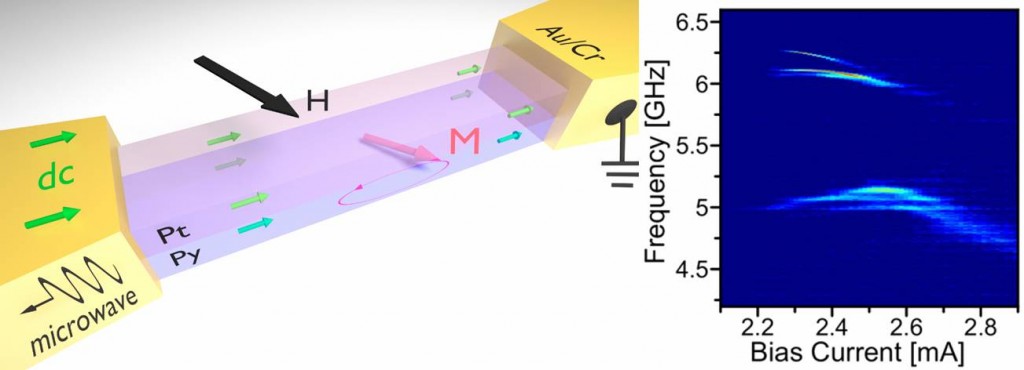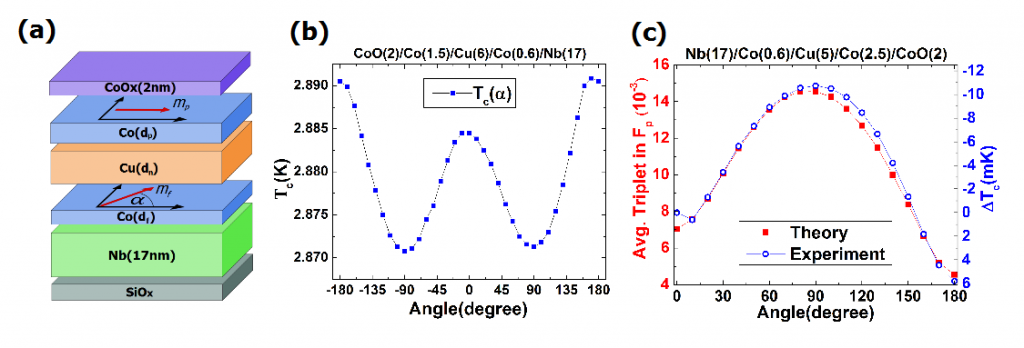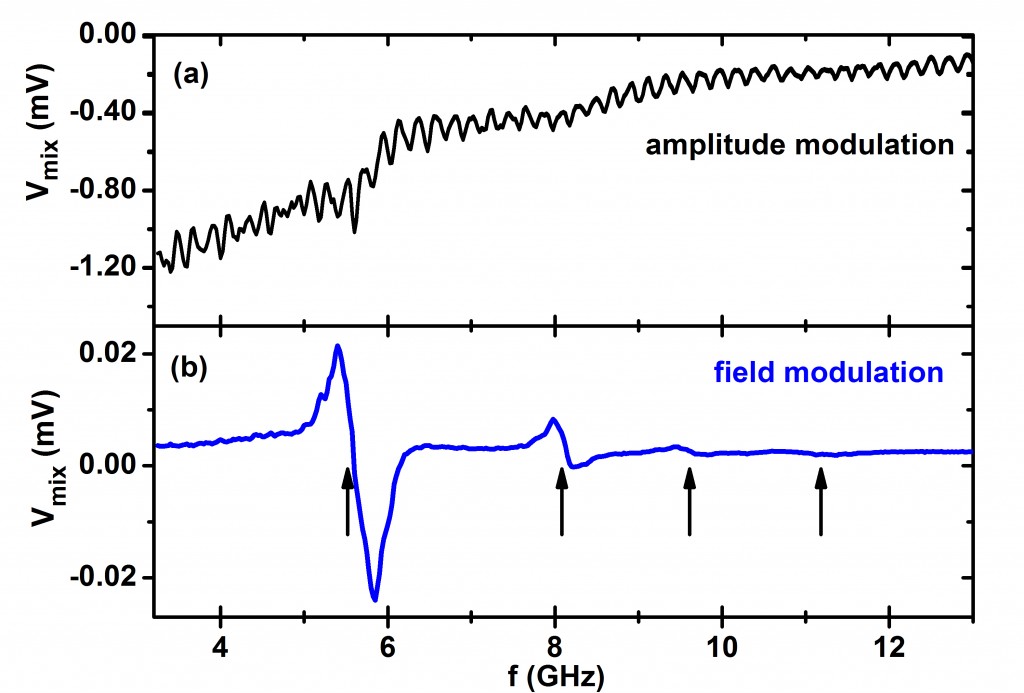Nanowire Spin Torque Oscillator Driven by Spin Orbit Torques
Contact persons: Zheng Duan, Andrew Smith, Liu Yang, Brian Youngblood
We demonstrated that current-induced spin orbit torques can excite self-oscillations of magnetization in Platinum/Permalloy (Pt/Py) nanowires [1]. The self-oscillations of magnetization result in a microwave signal emission from the nanowire at frequencies of the bulk and edge spin wave eigenmodes of the system. Our work shows that self-oscillations of magnetization can be excited by spin torque in a quasi-one dimensional ferromagnetic system.
FIG. 1: (left) Schematic of the Pt/Py nanowire device. (right) Spectra of the microwave signal emission from the nanowire as a function of applied current.
Reference:
[1] Zheng Duan, Andrew Smith, Liu Yang, Brian Youngblood, J. Lindner, V. E. Demidov, S. O. Demokritov, and Ilya N. Krivorotov
Nat. Commun. 5, 5616 (2014) [DOI]
Field-dependent perpendicular magnetic anisotropy in CoFeB thin films
Contact persons: Igor Barsukov, Yu-Jin Chen, Chris Safranski
Understanding the perpendicular magnetic anisotropy (PMA) in thin ferromagnetic films of CoFeB alloys is central to the development of spin torque memory (STT-RAM) devices. We have recently discovered that PMA in ultrathin CoFeB exhibits unusual dependence on the external magnetic field [1]. In particular, we have shown that PMA in Ta/Co20Fe60B20/MgO films varies with external field by as much as 0.1 Tesla [see Fig. 1(a)]. We explain this effect in terms of inhomogeneous interfacial spin pinning arising from a magnetic oxide formation at the Co20Fe60B20/MgO interface. The existence of the magnetic oxides is confirmed by distinct transitions in the temperature dependence of the magnetization and resistance of the CoFeB films [see Fig. 1(b)]. Our results suggest that the interfacial spin configuration in ultrathin Co20Fe60B20 films widely used in STT-RAM devices may be more complicated than previously thought [1].
FIG. 1: (a) Perpendicular uniaxial magnetic anisotropy field as a function of external field for a 2.0 nm CoFeB film. (b) Magnetization of a 2.5 nm CoFeB film as a function of temperature.
Reference:
[1] I. Barsukov, Yu Fu, A. M. Gonçalves, M. Spasova, M. Farle, L. C. Sampaio, R. E. Arias, I. N. Krivorotov
Appl. Phys. Lett. 105, 152403 (2014) [DOI]
Angular Dependence of Superconductivity in Superconductor / Spin Valve Heterostructures
Contact persons: Alejandro A. Jara, Christopher Safranski
The superconductivity in superconductor / ferromagnet (S/F) multilayers can exhibit unusual properties such as long-range triplet condensate induced by the proximity effect. We recently demonstrated [1] magnetic control of the triplet component of the condensate in CoO/Co/Cu/Co/Nb superconducting spin valves shown in Fig. 1(a). We find that the superconducting transition temperature Tc shows non-monotonic dependence on the angle between the spin valve magnetic moments, as shown in Fig. 1(b). The minimum in Tc near the orthogonal orientation of the magnetic moments is evidence of the enhanced long-range triplet amplitude in this maximally non-collinear configuration of the spin valve. We compare our data to theoretical predictions performed by our collaborators (groups of Prof. Oriol Valls and Dr. Klaus Halterman) and find excellent correlation between the calculated amplitude of the induced triplet component and measured angular dependence of Tc, as illustrated in Fig. 1(c).
FIG. 1: (a) Schematic of the CoO(2 nm)/ Co(dp)/ Cu(dn)/ Co(df )/ Nb(17 nm) multilayer, where α is the in-plane angle between the magnetic moments of the Co layers. (b) Superconducting transition temperature, Tc, versus magnetic field angle, α, measured at a field of 800 Oe. (c) The theoretical triplet amplitudes (left scale) and the experimental ΔTc (right inverted scale) as a function of angle, α.
Reference:
[1] Alejandro A. Jara, Christopher Safranski, Ilya N. Krivorotov, Chien-Te Wu, Abdul N. Malmi-Kakkada, Oriol T. Valls, and Klaus Halterman
Phys. Rev. B 89, 184502 (2014) [DOI]
Spin Torque Ferromagnetic Resonance with Magnetic Field Modulation
Contact persons: Igor Barsukov, Alexandre Goncalves, Yu-Jin Chen
We developed a technique of broadband spin torque ferromagnetic resonance (ST-FMR) with magnetic field modulation for measurements of spin wave properties in magnetic nanostructures. This technique gives great improvement in sensitivity over the conventional ST-FMR measurements and circumvents the drawbacks of the conventional ST-FMR. Application of this technique to nanoscale magnetic tunnel junctions (MTJs) gives reliable information on magnetization dynamics for an arbitrary magnetic state of the MTJ, including the collinear conguration. The high sensitivity of the technique allows us to measure the entire spectrum of low-frequency standing spin waves in MTJs in great detail.
FIG. 1: Spin torque driven FMR spectra of a 170 x 90 nm^2 elliptical MTJ nanopillar with external magnetic field of 30 mT in easy axis: (a) with amplitude modulation (conventional ST-FMR). (b) Field modulation removes large frequency-dependent background of non-magnetic origin and exposes several spin wave eigenmodes of the MTJ.
Reference:
[1] Alexandre M. Goncalves, Igor Barsukov, Yu-Jin Chen, Liu Yang, J. A. Katine, and Ilya N. Krivorotov
Appl. Phys. Lett. 103, 172406 (2013) [DOI]



